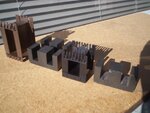risingstar
Newbie level 4
Hi. I am new here. I like this forum as I have been gaining a lot there. Please anybody who can advice me on the choice of toroidal cores for inverter above 3kva.
If I combined two or more cores for more power delivery, how does it affect the calculations for windings? I enjoyed Tahmid contributions very much. More power to your elbow.
If I combined two or more cores for more power delivery, how does it affect the calculations for windings? I enjoyed Tahmid contributions very much. More power to your elbow.
